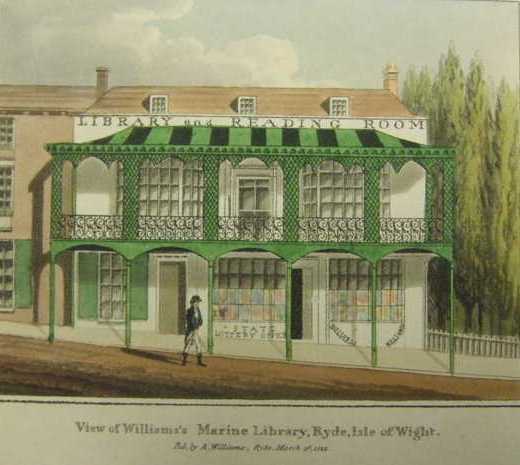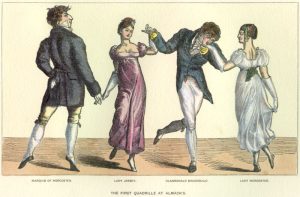The Assembly Rooms in Regency Ryde
In Georgian times Assembly Rooms were gathering places for members of the higher social classes In large cities and in spa towns such as Bath, they could accommodate hundreds of people. Assemblies played an important part in the marriage market of the day.
A major set of Assembly Rooms consisted of a main room, often used for balls, and several smaller rooms for activities such as card parties, music, and tea or supper. In smaller towns an Assembly Room was often attached to the best inn or as in Ryde’s case, a library.
Clarke in 1819 writes: This charming town has to boast of an excellent circulating library and assembly room, which the proprietor, Mr. Browne, has shewn every solicitude to render in all respects worthy of honourable mention. A choice stock of books and music, with a regular supply of the best and newest publications in each department, are always to be found at this truly respectable establishment.
Kidd in 1833 relates: Assembly Rooms- During the summer season, there is an assembly every week; in the winter, once in every month. The rooms where they are held, form part of the handsome Library of Mr. P. T. Hellyer, in Union Street, which is abundantly supplied with  all the popular novels of the day, and other works of general literature.
all the popular novels of the day, and other works of general literature.
Kidd in 1833 describes Ryde’s Assembly Room: The front is adorned with a handsome balcony, and from the veranda is an extensive sea view. The evening is enlivened by a varied selection of music, and the introduction of card parties. Mr. Hellyer has added an excellent Billiard Table thus rendering his establishment complete in every department, and deserving the cordial support of the numerous visitors of Ryde.
This building is also sometimes referred to as the Marine Library.
Ryde’s Assembly Room was not large enough for dancing and in early Georgian times balls were generally only conducted in the large houses of the wealthy, such as Westfield and Appley Towers. The building of the Town Hall in the 1820s changed the situation. As Kidd writes: The Town Hall is erected over the Corn Market; it consists of an elegant room, forty-four feet by twenty-six, opening by sliding doors into a room, fifteen feet by twenty, where the Commissioners for improving the town hold monthly meetings. When both rooms are thrown into one, it forms a room sixty feet in length: the view from this apartment is very extensive, and delightful. Balls may be held here.

Sources: Background information on Assembly Rooms from Wikipedia; The Delineator of the Isle of Wight, Clarke 1819; Kidd’s Picturesque Companion to the Isle of Wight, 1833, including sketch of Ryde Assembly Rooms – from Isle of Wight Record Office.
Picture Sources: The Marine Library from Ann Barrett’s Collection; Almack’s Regency Dance from Wikicommons.

